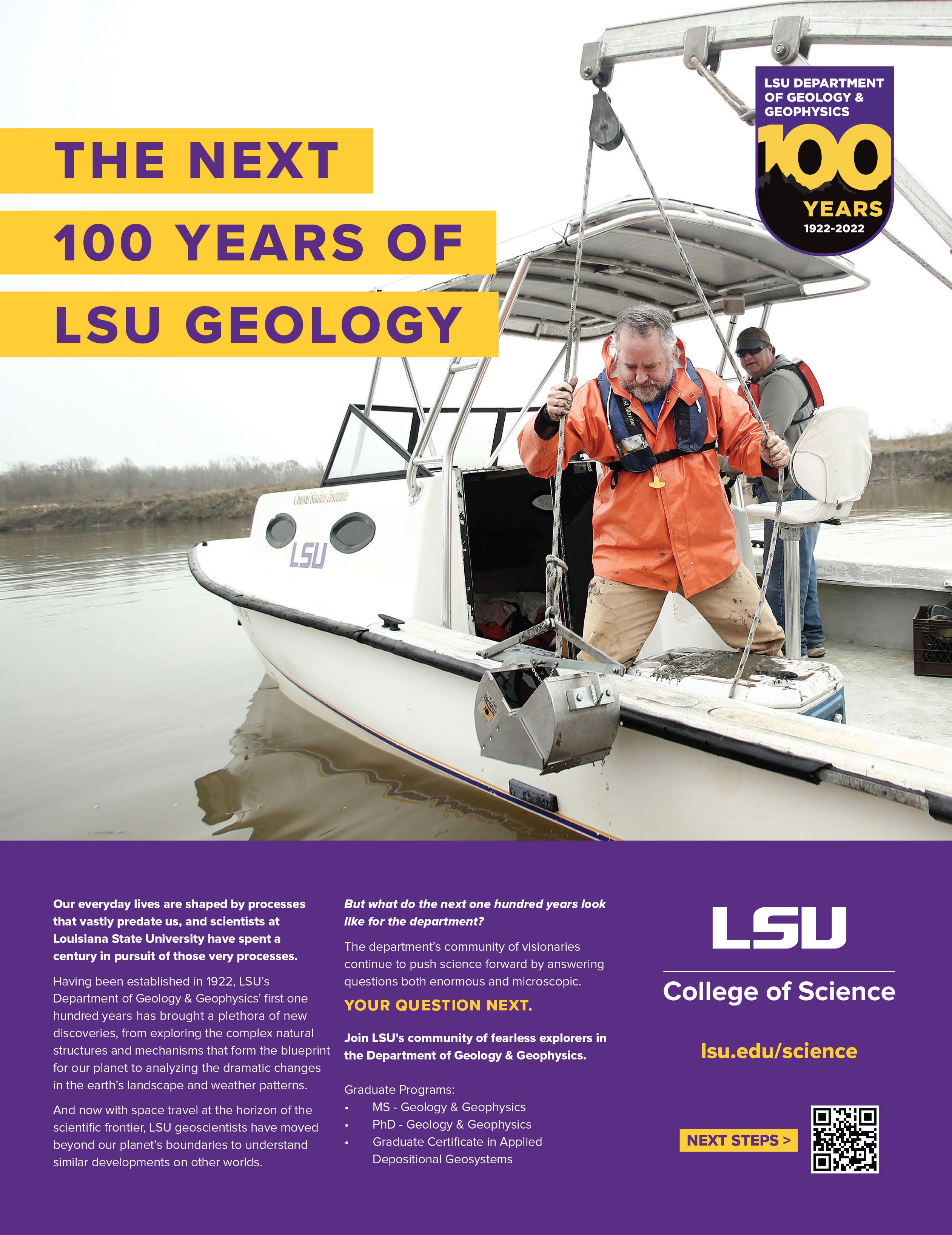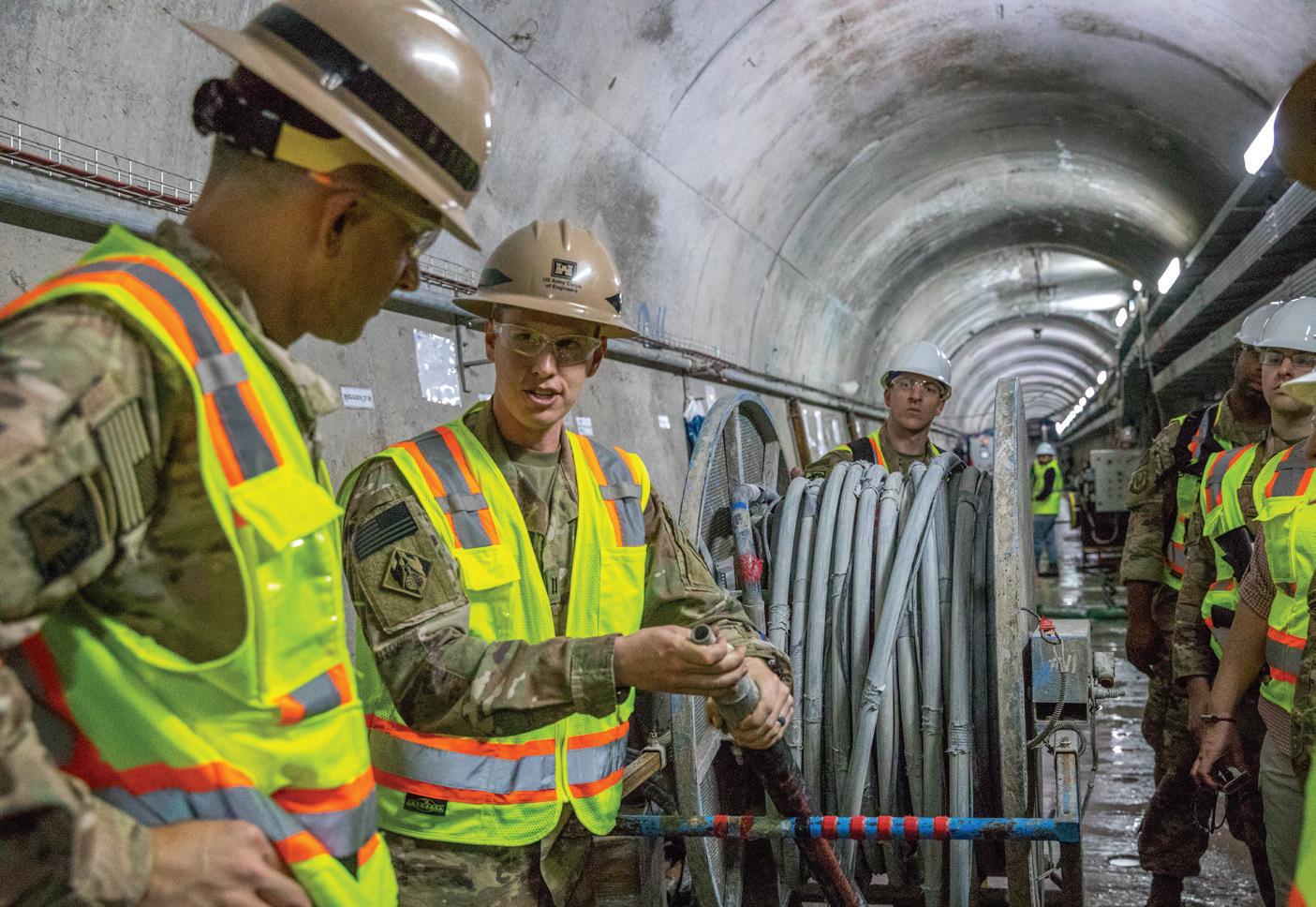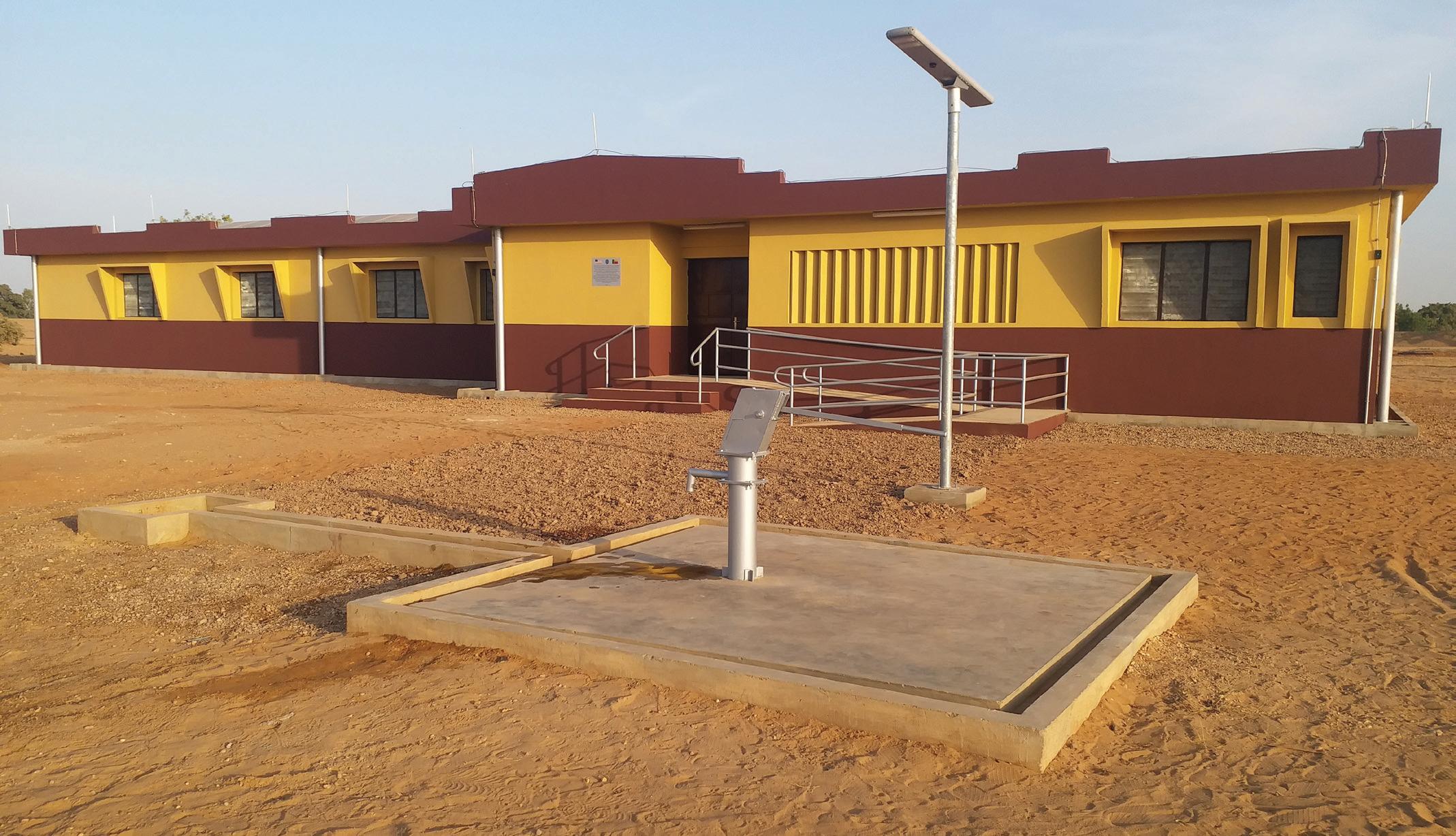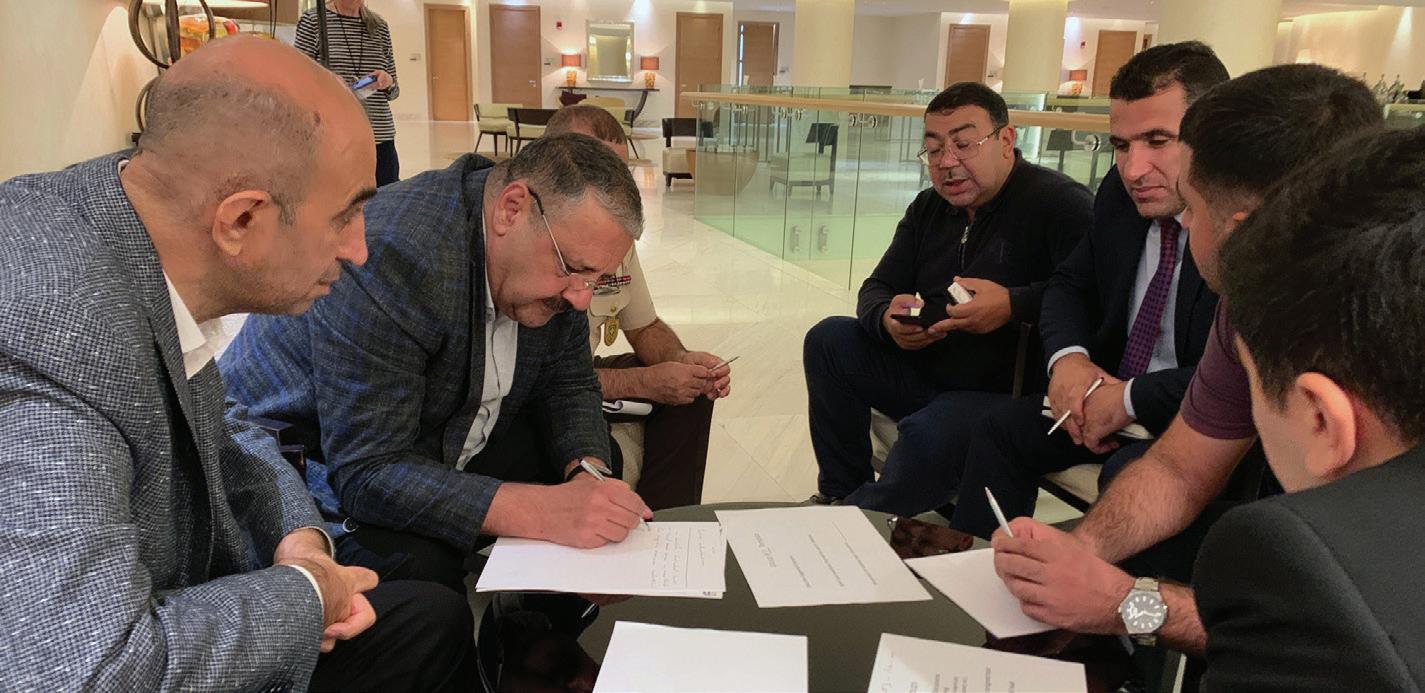
17 minute read
U.S. Army Corps of Engineers: Providing Technical Expertise Around the Globe
U.S. ARMY CORPS OF ENGINEERS – PROVIDING TECHNICAL EXPERTISE
BY CRAIG COLLINS, AMERICA'S ENGINEERS
It happened in Honduras: The BuckEye sensor system, combining a digital camera and light detection and ranging (LiDAR), was flown aboard a Super King Air turboprop aircraft over some of the Central American nation’s most flood-prone areas. The resulting geophysical data was used to create two- and three-dimensional colored maps, down to a resolution of 6 inches, over more than 5,400 square kilometers – elevation models that will allow engineers to assess and build infrastructure, reduce flood risk, and plan for humanitarian assistance and disaster relief. The collection flights were completed in February 2022.
BuckEye was developed in 2004 by the U.S. Army Engineer Research and Development Center (ERDC) to support warfighters with geophysical maps and urban terrain data that could be used in conducting tactical surveillance, intelligence, and reconnaissance in Iraq and Afghanistan. In the years since, the experts who developed this technology, along with U.S. Army Corps of Engineers (USACE) customers and partners around the world, have capitalized on the many potential uses for the unclassified color imagery and LiDAR elevation data collected by the system. In 2012, BuckEye was deployed in support of operations by U.S. Africa Command (AFRICOM). In recent years, BuckEye’s high-resolution three-dimensional (HR3D) imagery and data have been used to support a series of engineering initiatives in Florida’s Okeechobee watershed, and to create “digital twins” of sections of the U.S. border wall, which can be used to support construction, maintenance, and repair.

A Beechcraft Super King Air conducts a calibration flight for the Joint Airborne Lidar Bathymetry Technical Center of Expertise (JALBTCX) at Stennis International Airport, Mississippi, on April 18, 2022. JALBTCX surveys the sandy shoreline of the U.S. on a reoccurring basis. The high-resolution, three-dimensional data collected aboard the aircraft, by a system originally developed to support warfighters, has been used to great beneficial effect at home and abroad.
USACE PHOTO BY CHUCK WALKER
– David Hibner, Director of the Army Geospatial Center
According to David Hibner, who directs the Army Geospatial Center, the data and intelligence generated by the center’s experts serve several USACE missions: For example, to update and manage the inland electronic navigation charts that enable travel on 7,000 miles of intracoastal waterways, and provide the geospatial information that enables the modernization and maintenance of the nation’s 91,468 dams. “In terms of our international partnerships,” Hibner said, “the most obvious example is our BuckEye program. We do a lot of things with partner nations, with interagency partners – and, of course, we do a lot to support our Army and our combatant commands.”
Aircraft-mounted sensors collecting data for making HR3D watershed maps in Honduras, was not something Col. Richard Gridley imagined when he was appointed the U.S. Army’s first chief engineer in June 1775 – he was busy trying to win the Revolutionary War, recruiting the sappers, miners, and engineers who would design and build batteries and fortifications for the Continental Army. But neither did Gridley, nor his immediate successors, likely foresee the events that would, over the next two-and-a-half centuries, compel the United States to assign the Army’s engineers authority and responsibility to address some of the nation’s most crucial issues: overseas contingency operations, inland navigation, flood protection, water resources development, environmental restoration, emergency response, and more.
[continued below]

WWW.LSU.EDU/SCIENCE
(ADVERTISEMENT)
Today’s Corps of Engineers is noteworthy not only for this diverse mission set, but also for the global demand for its expertise and services:
• In South Korea, biologists with USACE's Far East District work with partners in the South Korean government and environmental community to prevent or minimize the impact of U.S. military facilities on natural resources and species. In the country’s most populous province, containing the capital of Seoul and its surrounding communities, 13 protected species have been identified, and the Integrated Natural Resources Management Plan, the joint effort to protect these species at the facilities of U.S. Forces-Korea, has produced a set of recommendations, in alignment with South Korean law and environmental policy, for personnel at these installations to manage surrounding natural resources.
• From its home in USACE’s Middle East District, the Technical Center of Expertise (TCX) for Aircraft Hangar Fire Protection shares its knowledge around the globe, designing, constructing, inspecting, and maintaining systems designed to protect assets often valued in the billions of dollars. USACE fire protection engineers have recently provided services in Honduras, India, Korea, Germany, Norway, and the Bahamas.
• In Mosul, Iraq, the Mosul Dam Task Force, a group consisting of 50 to 70 Soldiers, USACE civilian engineers, Iraqi engineers, and employees of private construction firms, worked to prevent the catastrophic collapse of Iraq’s largest dam – considered by many experts to be the world’s most dangerous dam. While USACE’s engineering experts helped to stabilize the dam with the largest drilling and grouting project ever undertaken, USACE project managers helped integrate the team of engineers and technical specialists – from the United States, Iraq, and other partner nations – who would train and build a capable, resilient Iraqi Ministry of Water Resources, a team equipped and capable of maintaining Mosul Dam into the future. With this mission accomplished, the task force left Iraq in the summer of 2019.
• In the West Africa republic of Benin, engineers from USACE’s Europe District implemented and managed the construction of two medical facilities in the remote villages of Money and Godjekoara, both of which lie near a volatile border area under constant threat from violent extremist groups and transnational crime. The facilities, completed in spring 2021, were funded by AFRICOM and coordinated with the U.S. State Department. The clinics offer an alternative to villagers who had been compelled to cross the border and seek care in either Niger or Burkina Faso; they give rural citizens secure places to seek health care and document the birth of new Beninese citizens – who, in the border region, have been at risk of human trafficking. The work of USACE in completing these and other humanitarian assistance projects in Africa – including the construction of several schools in Benin – is critical to meeting the missions and priorities of both AFRICOM and the State Department.

U.S. Army Capt. William Megon, Mosul Dam Task Force logistics officer, explains the use of a grout reel in Mosul, Iraq, May 12, 2019. The grout reel is used in the emergency drilling and grouting operations within the grouting gallery.
U.S. ARMY RESERVE PHOTO BY STAFF SGT. JOSHUA HAMMOCK
Today’s Corps of Engineers
The U.S. Army Corps of Engineers employs more than 36,000 civilians and 800 active-duty service members, who provide a suite of services to customers in more than 130 countries worldwide. It is an agency in the midst of a historic transformation: Typically authorized to execute an annual program of around $20 billion to $22 billion, USACE, at the outset of the 2023 fiscal year, was charged with performing between $90 billion and $95 billion in annual work – an increase largely due to projects authorized through the Infrastructure Investment and Jobs Act (also known as the Bipartisan Infrastructure Law) of 2021.

A recently completed health clinic, with a water well hand pump on a concrete pad and a solar-powered light pole in the foreground, is seen here in the remote village of Money in Benin in Africa.
PHOTO COURTESY OF COSME QUENUM
It’s important, when looking at these numbers, to remember that they represent the value of the projects USACE works on, not its budgetary appropriation. Most of the projects in the USACE portfolio are funded in whole or in part by customers who solicit the expertise of the Corps of Engineers. “We are a project-funded organization,” said USACE’s Director of Military Programs Christine Altendorf. “Our people work on projects in their various stages – planning, construction, operations, and maintenance – and we bill for those services. But we work for the federal government, and we don’t do anything that isn’t authorized.”
This workload is shared between two core mission areas:
MILITARY PROGRAMS.
At its inception, USACE’s mission was to serve the warfighters of the Continental Army; one of its first tasks was to build fortifications at Bunker Hill, near Boston. Today’s Corps of Engineers supports the Army’s Engineer Regiment, headquartered at Fort Leonard Wood, Missouri. The Army engineers in this regiment compose units that perform combat engineering, rescue, construction, and other specialties, and all fall under the command of the Army Chief of Staff. The only uniformed unit that falls directly under the command of USACE is the 249th Engineer Battalion (Prime Power), which provides commercial-level power to military units and federal relief organizations in time of need.
USACE carries out a program of military construction (MILCON) and installation readiness – designing, building, or upgrading facilities or infrastructure for:
• the Department of the Army ($4.9 billion at 287 installations throughout the United States).
• Air Force, Navy, the Defense Health Agency; and the Defense Logistics agency ($10.7 billion) installations and infrastructure; and
• the Missile Defense Agency ($875 million to five critical projects in Romania, Poland, and Alaska).
For the Army, said Altendorf, USACE doesn’t just build real estate – it buys, sells, and manages it. “We’re responsible for about 25 million acres of land,” she said, “and our real estate people do about 46,000 real estate transactions a year.”

WWW.WF-IB.DE/EN
(ADVERTISEMENT)
USACE offers additional engineering support to the Department of Defense (DOD) and the other service branches – for example, $5 billion in support to the activities of the 11 combatant commands (COCOMs), such as SOUTHCOM, AFRICOM, etc.
Every year, USACE performs about $2 billion in environmental remediation work, providing technical expertise in cleanup and environmental restoration. This work is often done in collaboration with the other service branches, through programs such as Formerly Used Defense Sites (FUDS); with the Department of Energy, to clean up sites used by the U.S. Atomic Energy Commission; and with the Environmental Protection Agency (EPA), which executes the Brownfields and Superfund programs.
Another USACE military mission is known broadly as Interagency and International Support (IIS), through which the Corps of Engineers provides $4 billion in technical assistance annually to about 70 non-DOD federal agencies, state and local governments, tribal nations, foreign governments, NGOs, and private U.S. companies. This includes USACE competencies in disaster response and humanitarian assistance – expenditures that vary from year to year, depending on need. USACE also provides design, construction, engineering, and training to these non-DOD customers, including the design and construction of 22 projects for the Department of Veterans Affairs worth $8.7 billion, and $3.7 billion worth of Foreign Military Sales projects in 35 other countries. Other federal customers for whom USACE has recently designed, built, or renovated facilities include the U.S. Department of Agriculture, the State Department, and the Bureau of Engraving and Printing.
CIVIL WORKS.
Now the largest USACE work portfolio in terms of personnel and other resources, the Civil Works mission grew naturally out of the nation’s demand for engineering expertise: In 1824, when Congress needed to survey road and canal routes for a nation that was rapidly expanding westward, it authorized the use of Army engineers for the task. In the same year, it assigned the Corps of Engineers responsibility for improving the safety and navigability of the Ohio and Mississippi rivers by removing sand bars, snags, and other hazards. In 1850, USACE built the nation’s first water supply project, the Washington Aqueduct; in the 1920s, it began building hydroelectric power plants.

A small portion of the flooded Okavango Delta is shown where the water is clear for about a foot or more. Locals claim this water is so clean that a person can drink directly from it. USACE personnel traveled to Botswana to assess opportunities to support water management and water security in the country’s Okavango Delta region.
USACE PHOTO
As the nation suffered devastating floods in the late 1920s, Congress assigned USACE work on projects in the Mississippi River and Sacramento River watersheds – and, in 1936, assigned the agency the mission to provide flood protection, which USACE and its other partners now more precisely refer to as “flood risk management.” In response to the devastating floods that compelled this legislation, USACE also expanded its role in responding to natural disasters.
USACE expertise became increasingly important in environmental preservation and restoration in the late 20th century, and, in recent decades, USACE helped lead some of the most ambitious environmental restoration efforts in history, including the Comprehensive Everglades Restoration Plan (CERP) – the largest environmental restoration project ever undertaken. The Clean Water Act and its amendments authorize USACE to issue or deny permits for the deposit of dredge and fill materials into the waters of the United States and their adjacent wetlands – an activity often linked to agriculture or land development.

WWW.USA.SIEMENS.COM/FEDERAL
(ADVERTISEMENT)
It’s difficult to capture the scope of everything USACE does today in its Civil Works mission area, but a few numbers offer a glimpse:
• USACE maintains or operates about 740 dams, and performs safety inspections of more than 2,000 federal and non-federal levees. Through its Dam and Levee Safety programs, it ensures that these sites meet criteria for safety and function. In collaboration with FEMA, it maintains the National Inventory of Dams, documenting data for all known dams in the United States and its territories;
• USACE now maintains an inland navigation system consisting of 25,000 miles of navigable channels and 196 commercial lock and dam sites;
• About 100 billion kilowatt-hours – onefourth of the nation’s annual hydropower supply and 3% of its total electrical capacity – is produced by 75 USACE-operated hydroelectric power plants on the nation’s river systems. The Corps of Engineers is the nation’s largest hydropower provider, and one of the largest in the world;
• USACE is one of the nation’s largest water-supply agencies, with 9.8 million acre-feet of water storage space available for municipal and industrial use; and
• USACE maintains more than 4,400 recreation sites – including 100,000 campsites and 3,800 boat ramps – on 12 million acres of land at more than 400 lakes nationwide. USACE lakes receive about 370 million visits annually, and more than a third of all the freshwater lake fishing that takes place in the United States happens on reservoirs maintained by the Corps of Engineers.
In the 2023 fiscal year, USACE’s Civil Works mission area is its fastest-growing. Already busy with $8.34 billion worth of projects, numbering more than 1,000 across the country, the agency is working with partners to implement more than $25 billion in disaster relief and emergency assistance in response to wildfires, hurricanes, earthquakes, and other natural disasters. The Infrastructure Investment and Jobs Act added more than $17 billion in additional work to the USACE civil works portfolio.
[continued below]

WWW.GATORPUMP.COM
(ADVERTISEMENT)
In support of its military and civil works missions, USACE conducts a varied and vigorous research and development program, valued at more than $1.3 billion annually, on more than 2,000 projects aimed at solving problems for the Army, DOD, and IIS customers. From its roots as the first federal civil engineering laboratory – the Waterways Experiment Station in Vicksburg, Mississippi, established in 1928 – the multi-facility research enterprise collectively known as ERDC provides science, technology, and expertise through its seven component laboratories:
• Geospatial Research Laboratory (GRL), Alexandria, Virginia;
• Coastal and Hydraulics Laboratory (CHL), Vicksburg, Mississippi;
• Cold Regions Research and Engineering Laboratory (CRREL), Hanover, New Hampshire;
• Construction Engineering Research Laboratory (CERL), Champaign, Illinois;
• Environmental Laboratory (EL), Vicksburg, Mississippi;
• Geotechnical and Structures Laboratory (GSL), Vicksburg, Mississippi; and
• Information Technology Laboratory (ITL), Vicksburg, Mississippi.
ERDC's wealth of expertise – among its 2,100 employees, about half are engineers and scientists with Ph.D. or M.S. degrees – has made it a frequent winner of the Army Research Laboratory of the Year Award. Its work, conducted on all seven continents and in the Arctic, is diverse, investigating not only solutions for American warfighters, but also improvements to the lives and lifestyles of people almost everywhere in the world.
Combining a Wealth of Talent ...
... Literally, almost everywhere in the world. USACE’s technical experts design packed-ice cargo-plane runways for Antarctica’s McMurdo Station; study water security in Botswana’s Okavango Delta; collaborate with their counterparts in Indonesia on structural awareness for urban search and rescue; work with Brazil’s National Water Agency on flood risk management planning and training; design and build Coastal Crisis Management Centers in Bangladesh; collaborate with professionals in the Netherlands to design coastal protection technologies; build schools and clinics in Vietnam; and much more.
Technical expertise is what USACE is famous for, but engineering is far from the only vocation necessary to achieve this rich and varied mission set: Nearly all the Corps of Engineers’ reservoirs are served by USACE park rangers who help ensure fun, safe recreation while also working on other missions, such as the control of invasive species with USACE ecologists and fish and wildlife biologists, or the preservation and protection of cultural resources with USACE archaeologists. Designing, building, and purchasing real estate require the expertise of architects, contracting and realty specialists; legal counsel, and – like every part of the USACE enterprise – increasingly skilled and knowledgeable information technology specialists and managers. Maintaining safety and navigability on 25,000 miles of channels demands a fleet of survey vessels, each of which must be crewed by capable operators.

U.S. and Azerbaijani military and civilian officials participate in a disaster response tabletop exercise Sept. 20-22 in Baku, Azerbaijan. The exercise was sponsored by the Civil Military Emergency Preparedness (CMEP) program and included the participation of first responders from Azerbaijan and the United States. CMEP program events facilitate inter-ministerial and civil-military cooperation, enhance armed forces capabilities to provide defense support to civil authority, and foster regional/multilateral cooperation to support response to disasters.
USACE PHOTO
To leverage this vast collection of wisdom and expertise in pursuit of efficient problem-solving and best practices, without the stove-piping and red tape that often hinder big bureaucracies, USACE has established nearly 50 Communities of Practice (COPs): groups, independent of formal organizational structures, who regularly interact to collectively learn, solve problems, build skills and competencies, and develop best practices around a shared concern, goal, mission, set of problems, or work practice. COPs are as varied as USACE vocations, and include emergency management; library; inland navigation design; radio and satellite communications; hydrology and hydraulics; internal review; collaboration and public participation – and dozens more.
USACE never works alone. Its partnerships are often local collaborations with stakeholders and officials to make decisions at specific sites, or on specific projects. Some of its regional collaborations have been historic, such as the Interagency Performance Evaluation Taskforce (IPET), a joint effort among more than 150 government, academic, and industry partners that convened to study and report on the performance of the hurricane protection system in New Orleans and southeast Louisiana during Hurricane Katrina in 2005. The USACE Institute for Water Resources (IWR) is among the USACE institutions that work on a variety of academic, domestic government, federal, and international partnerships –including, for example, USACE’s collaboration with the United Nations Educational, Scientific and Cultural Organization (UNESCO) to promote safe, efficient, and environmentally sound water management systems.
In September 2022, when Altendorf and a team of USACE disaster support experts visited the nation of Azerbaijan to practice earthquake preparedness and response, it was a reminder, she said, that – at least for the professionals in the Corps of Engineers – there is no meaningful distinction between “military” and “civil works” activities: “A lot of the people who are working right now on responses to hurricanes in the Atlantic, when they’re not working at home, will be on these small teams that go to countries all across the world.”
In Azerbaijan, the team worked with the Ministry of Emergency Situations, the Ministry of Defense, and other officials and stakeholders, to lead a natural disaster workshop and a tabletop exercise in response to a simulated earthquake – and shared the U.S. model for disaster relief, in which the military works in support of a civilian effort led by FEMA. Altendorf – who, several years ago, oversaw the USACE environmental mission – watched as her Azerbaijani counterparts grappled with the same issues our own nation debated as its emergency response and homeland security capabilities evolved: “A lot of different agencies know different things,” she said. “Nobody is able to pull it all together and see the whole elephant. Everybody has their part.” Azerbaijani officials began to see opportunities for drawing on the resources of other agencies – its State Border Service, for example, or its neighboring countries –to execute a more thorough and effective disaster response.
It’s a perfect example of how completely the collaborative mindset, which has brought USACE expertise to every corner of the globe, has infused the organization: Its experts are collaborating with partners to learn how to collaborate better. The technical prowess, agility, and varied skill set the U.S. Army Corps of Engineers – an agency with stakeholders in every conceivable community, working and living in every type of environment imaginable – are unmatched. But collaboration is the key to its success.

GET THE UPCOMING PRINT EDITION DELIVERED TO YOUR HOME OR OFFICE FOR FREE.
GO TO WWW.AMERICAS-ENGINEERS.COM/PRINT-SUBSCRIBE/










